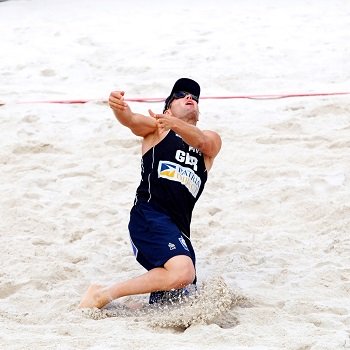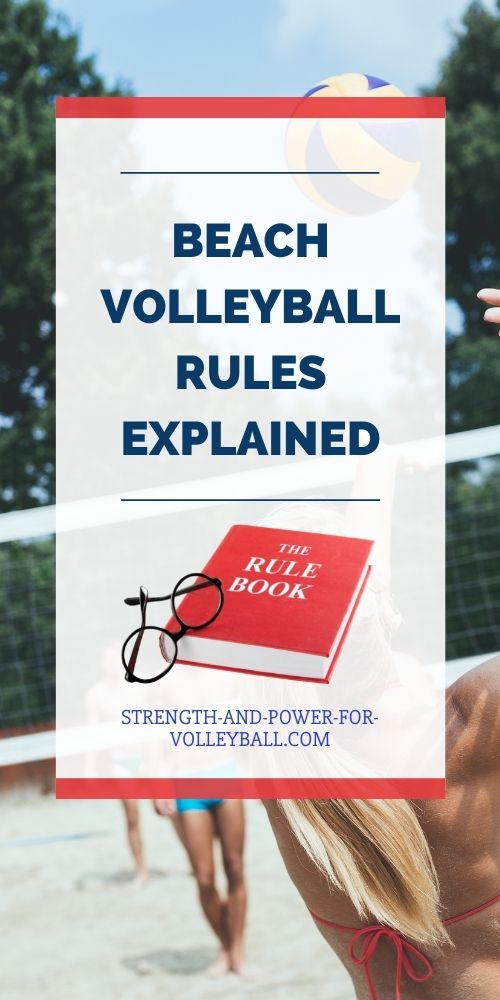Beach Volleyball Rules
Competitive Grass and Beach
For grass and beach volleyball rules, competition may consist of 2, 3, 4, or 6 player teams.
Types of outdoor volleyball competition are...
- Doubles
Two players on a team - Triples
Three players on the court for each team - Four Player
Four players on the court for each team - Six Player
Six players on the court for each team
All competitions must involve teams with the required number of players. Teams with less than the required number of players are incomplete and forfeit the set or match.
Scoring System - Beach Volleyball Rules
A Match
The match is won by the team that wins 2 sets. In the case that the match comes to a 1 to 1 tie, the deciding set is played to 15 points, with a minimum 2 point lead.
A Set
The first 2 sets are won by the team that scores 21 points first. In the case of a 20 to 20 tie, play is continued until one team has a 2 point advantage.
A Rally
Whenever a team fails in serving, fails to return the ball to the opponent, or commits any faults, the opposing team wins the rally.
The result of winning the rally...
- If the opponents served, they get a point and continue serving.
- If the opponents received the serve, they get a point and gain the right to serve next.
Playing Surface - Beach Volleyball Rules
Court Dimensions
The playing court is rectangle in shape and measures 16 X 8 meters (52' 6' X 26' 3'). Court dimensions for indoor volleyball are different. Compared to an indoor volleyball court, a beach court is a meter narrower and 2 meters shorter in length.
Beach volleyball rules for FIVB competition, the free zone surrounding the court should be a minimum of 5 meters to a maximum of 6 meters from the endlines and sidelines. There should be a minimum height of 12.5 meters (41 feet) of free space above the playing surface.
For Sand Volleyball...
- The playing surface should be made up of leveled sand, as flat and uniform as possible.
- The sand should not contain anything that could cut or injure players such as rocks or shells.
- For FIVB competition, sand must be at least 40 cm deep and made up of fine, loosely compact grains.
For Grass Volleyball...
- Courts should consist of grass surfaces that have been preserved free of puddles, holes, or uneven ground.
Court Lines - Beach Volleyball Rules
Lines on the Court
- The court is mark with 2 endlines and 2 sidelines.
- There is no centerline.
- All lines are 5 to 8 cm wide (2 to 3.75 inches).
- The color of the lines must contrast sharply with the color of the sand.
- Lines should be made of a resistant material.
- If anchors are used, they should be made of soft flexible material.
For Reverse Coed Grass Doubles or Reverse Sixes
- Attack lines are marked 3 meters (9'10") from the centerline to the attack line.
Equipment - Beach Volleyball Rules
Net Height
- Men - 2.43m (7'11 5/8")
- Women - 2.24m (7' 4 1/8")
Antenna
The antenna is a flexible rod made of fiberglass or a similar material. The antenna is considered part of the net and sets the limit to the crossing space.
Net Posts
The posts must be round and smooth. Posts must be placed an equal distance from each sideline to the post padding. Posts can't consist of any dangerous or obstructing devices.
If anchors for guy lines are used, they must be driven flush, free of sharp edges or buried beneath the playing surface.
The Ball
The ball must be made of material more suitable for outdoor conditions since matches may be played when it is raining. The ball should be bright in color (white, orange, or yellow, etc.).
- The weight of the ball should be 9 to 10 ounces.
- The inside pressure of the ball should be 2.5 to 3.2 lb/sq inch.
- International competition must use homologated balls.
Participants - Beach Volleyball Rules
For Doubles
Teams are limited to two participants.
For Triples
The roster is limited to 5 players, unless otherwise specified by the tournament director.
For Fours
The roster is limited to 6 players, unless otherwise specified by the tournament director.
For Doubles, Fours, and Six Player Competitions
Coed or reverse coed teams must contain an equal number of players on each team, unless otherwise specified by the tournament director.
For Triples Competitions
Beach volleyball rules for coed and reverse coed, teams must contain at least one male and one female player, unless otherwise specified by the tournament director. Opposing teams need not contain equal numbers of males and females.
References
Kenda S. Lenberg: USA Volleyball Domestic Competition Regulations.
If you enjoyed these tips and would like to keep it close to you at any time, just save this pin to your Pinterest Volleyball Training Board.
Beach Volleyball Rules Related Pages
Strategies for Beach
Beach volleyball strategy for being winning on the beach involves understanding how to serve your opponent and set your partner. You need to have a good defensive strategy.
Hand Setting Rules
Beach hand set rules for setting in beach volleyball. Do you know the rules for setting in sand doubles? Learn the rules for setting and how to set to avoid
Pro Beach
Professional beach volleyball history and why this sport is so popular. Improve your indoor game by playing on the beach. There are many reasons why beach volleyball is more fun to play than indoor...
Learning Beach
Do you understand the basics to playing volleyball on the beach? Learn serve receive strategy that's critical for being successful on the beach. How to play defense and block in doubles...
Hitting on the Beach
Key points include consistent approach, armswing, maximum or near maximum jump, learning all seven volleyball hitting options...
Playing Sand
Playing beach volleyball will not only make you a better indoor player, but it's also easier on your body. Doubles teaches you...
How to Play Beach
Just because you're experienced at indoor doesn't mean playing on the beach will be easy. Beach volleyball can be very intimidating for players because...
Digging on the Beach
Digging on the beach is a tough skill to master. When playing sand doubles, often you are playing defense with no block up. This makes digging hard-driven balls...
Beach Serves
Serving is important part of playing beach volleyball, so don't take serving for granted. If you just serve the ball over the net without a strategy...
Passing on the Beach
Passing on the beach is much different than indoor. It can be tough to move around in the sand and get in good position to pass. Forearm passing techniques...
Beach Spike Techniques
Pro beach spike techniques are a little different than when jumping off a hard indoor surface. For one thing, it's very difficult to broad jump out of sand...
Setting on the Beach
Setting techniques for the beach. Techniques for hand setting on the beach are much different than indoor volleyball. Techniques for bump setting...
Beach Blocks
Basic blocking technique includes watching the set, then the hitter's approach, then his or her shoulder. Be aware of your hand placement. Penetration...
Beach Hand Signals
Hand signals are important for partner communication. Signaling line, angle, and no block helps the defender know what court is being taken away and what court to cover...
Serves and Strategies
Serve steady consistent heat to break a team down. Learn different serving strategies. Cross-court heat, change-up, deep rainbow jumper, jump floater, sky ball...
Doubles Volleyball
Doubles volleyball is a great way to learn how to play volleyball. Playing "two on two" volleyball can make you a much better sixes player. At first, many players are intimidated by the fast pace of the game. Don't get overwhelmed. You'll soon figure it out...
Manhattan 6 Man Beach Tournament
Manhattan 6 man pro volleyball teams from pro to amateur dress up in wild costumes, play volleyball, and party at the beach. This tournament is usually around...
Volleyball › Beach Volleyball Rules

